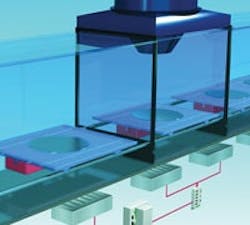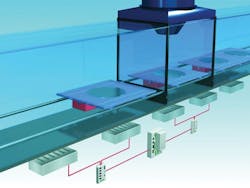In 2011, Aaron Hand was the managing editor for Control Design and for Industrial Networking.
Although the growth in digital data means strong demand for hard disk storage media, a maturing market has manufacturers facing increasing pressures on pricing, which puts more emphasis on throughput.
"The disk drive industry is very mature. There is a lot of pricing pressure," says Chuck Liu, general manager for hard disk drive products at Intevac in Santa Clara, Calif. "Higher throughput is the key to lowering our customers' capital costs per disk."
Intevac, in business since 1991, is the leading supplier of magnetic media processing tools. The machine builder looked for a way to increase throughput on its perpendicular magnetic recording (PMR) 200 Lean system. A key goal for its second-generation tool was to develop a transport system that would enable significantly faster throughput. To accomplish this, Intevac engineers integrated a new linear motion system (LMS), boosting throughput by 25%.
The 200 Lean hard disk sputtering tool is used to produce 3.5 and 2.5 in. hard disks. Each process station inside the tool deposits a specific layer of the media structure. "Most hard disk manufacturers use 20 stations," Liu says. "Bosch Rexroth demonstrated that its linear motion system could cut transport time between stations by 50%. This increases production from 800 disks with the 200 Lean to 1,000 disks per hour with our Gen II system."
In the Gen II design, the disk carriers move independently at high speed and with high precision using the non-contact LMS, which uses inverted linear motors with coils embedded in the track and a magnetic plate embedded in each disk carrier. In the Gen I design, each chamber had a set of motor-controlled rollers that drove the carrier. But there was concern about the defects that were generated from the drive system, with the rollers inside the vacuum. Another issue was preventive maintenance time. "The alignment of drive mechanism is rather difficult," Liu says. "It takes skill and takes time." The Gen II system makes the wheels simple to align, and easy to maintain.
Particles generated inside the tool's vacuum chamber are a key concern in today's hard disk technology, which is less tolerant of those particles because of increased aerial density — the measure of storage bits that a hard disk manufacturer can squeeze into a piece of real estate. When IBM introduced the first hard disk in 1956, its aerial density was 2,000 bit/in.2. Today's PMR method is expected to be able to reach an aerial density of about 1 Tb/in.2.
A key aim of Intevac's machine redesign was to get the moving parts outside the vacuum. The system has 20 chambers, with elevators moving carriers and disks between chambers. "We used to have a ball screw type of drive inside the vacuum, which was heavily greased up," Liu says. "We had to shield it very good so it wouldn't generate defects. In Gen II, the ball screw is outside the vacuum, magnetically coupled to the drive inside the vacuum. We use that technology in quite a few places."
About the Author
Aaron Hand
Aaron Hand

Leaders relevant to this article:


